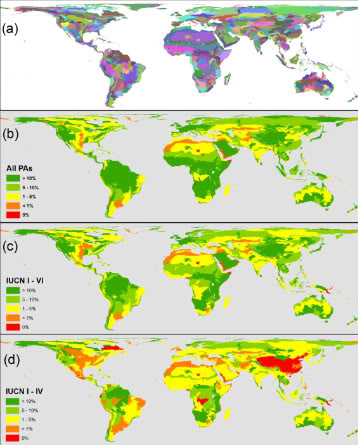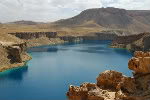It is unlikely that world governments will keep their pledge to protect 10 percent of every ecological region by 2010, according to a new study published in Biological Conservation. This goal is just one of many agreed upon by world governments through the Convention on Biological Diversity. With less than a year to the goal’s deadline, the study found that half of the world’s ecoregions are currently below the 10 percent threshold.
“Without major investments in conservation, spread across the world’s ecosystems, the world is likely to miss the 2010 Target,” says Clinton Jenkins, co-author of the paper and professor at the University of Maryland. “We should not despair though. Reaching the 10 percent goal in 2011 or 2015 or later will still be a major societal achievement, helping preserve the world’s natural heritage for future generations.”
 Click to enlarge Percent of each ecoregion protected. (a) Global distribution of ecoregions. Percent of each ecoregion protected within (b) all PAs, (c) IUCN PAs, and (d) strict PAs. Graph courtesy of Clinton Jenkins. |
Employing the 20009 World Database on Protected Areas, Jenkins and co-author Lukas Joppa analyzed the percentage of protected area in 821 ecoregions identified by the World Wildlife Fund ecoregions database. In addition to half of the world’s ecoregions having less than 10 percent of their area protected, more than three-quarters of the eco-regions have less than 10 percent under strict protection (in other words, rated by the IUCN as levels I-IV).
The authors note that ecoregions which have reached the goal of 10 percent protection (or above) are largely found in southern Africa, the Amazon, southern Australia, western US and Alaska. Areas of the world where protection is lacking includes China, the eastern and mid-west US, Mexico, and north Africa.
Certain ecozones (also known as biogeographical realms) also fared better than others. There are eight ecozones in the world as delineated by WWF: the Nearctic, Palearctic, Neotropic, Afrotropic, Australasia, Indo-Malaya, Oceania, and Antarctic. The study found that the Neotropics is the best protected ecozone in the world with 20 percent of its area under some form of protection. On the other end of the spectrum, Oceania is the least protected: 3 percent of its land is under protection, while only 1 percent is under strict protection.
In total the study found that 12.85 percent of the world’s land area is currently under some form of protection. This includes a stunning expansion of protected lands in the past 20 years. In 1985 a survey estimated that 3.48 percent of world’s land area was under protected; this number rose to nearly 9 percent by 1997; and now twelve years later has reached almost 13 percent.
“The true expansions of the global protected area system are encouraging, for they suggest the world’s governments are setting aside more land for environmental protection,” the authors write. However, it should be noted that less than half of the total area actually incorporates strict protection for biodiversity, the goal of the Convention on Biological Diversity.
 Click to enlarge Protected areas since 2003. Graph courtesy of Clinton Jenkins. |
Since 2003, the authors of the study found that protected areas are expanding by 0.13 percent every year. Yet, surprisingly, the majority of this expansion has taken place in a single country: 74 percent of area protected since 2003 occurred in Brazil. While this statistic is notable for highlighting Brazil’s conservation efforts, it also shows that creation of protected areas has likely slowed elsewhere in the world.
The authors write that while protected areas are essential for biodiversity conservation, more protected land may not always be the best way forward. “Many parts of the world now have substantial fractions of their land area under formal protection. In those areas, we suggest that shifting efforts toward implementation and enforcement of protection in already declared protected areas may best serve conservation. In some parts of the world though, there is still a distinct lack of protected areas. In those cases, there is still a need to set aside more land for protection.”
Joppa, a doctoral student at the Nicholas School, concludes that “protected areas are the best chance we have to save the world’s biodiversity, and they are going to play an increasing role in climate change negotiations as well.” He adds that “missing a conservation milestone is regrettable, but we hope our results turn attention to the achievable tasks at hand, and not to what the world has failed to accomplish.”
Citation: Jenkins, C.N., Joppa, L. Expansion of the global terrestrial protected area system. Biol. Conserv. (2009), doi:10.1016/j.biocon.2009.04.016
Related articles
New rainforest reserve in Congo benefits bonobos and locals
(05/25/2009) A partnership between local villages and conservation groups, headed up by the Bonobo Conservation Initiative (BCI), has led to the creation of a new 1,847 square mile (4,875 square kilometer) reserve in the Democratic Republic of Congo (DRC). The reserve will save some of the region’s last pristine forests: ensuring the survival of the embattled bonobo—the least-known of the world’s four great ape species—and protecting a wide variety of biodiversity from the Congo peacock to the dwarf crocodile. However, the Kokolopori Bonobo Reserve is worth attention for another reason: every step of its creation—from biological surveys to reserve management—has been run by the local Congolese NGO and villages of Kokolopori.
Peru gets $120m to protect 212,000 sq mi of Amazon rainforest
(05/13/2009) The Japanese government will loan Peru $120 million to protect 55 million hectares (212,000 square miles) of Amazon rainforest over the next ten years, reports El Comercio.
Afghanistan announces first national park on Earth Day

(04/22/2009) War-wearied Afghanis received uplifting news on Earth Day this year. Their nation has announced the creation of the nation’s first national park, Band-e-Amir, protecting a one-of-a-kind landscape encompassing six sky-blue lakes separated by natural dams. Announced by Afghanistan’s National Environmental Protection Agency (NEPA) at a ceremony in the FAO Building at the Ministry of Agriculture, Irrigation, and Livestock in Kabul this morning, key funding for the park was provided by The United States Agency for International Development (USAID).







